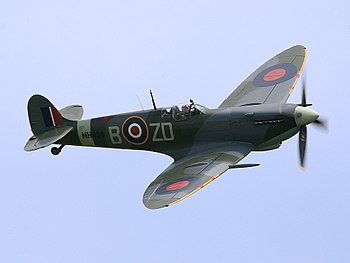The aerospace industry of the United Kingdom is the second-largest national aerospace industry in the world (after the United States) and the largest in Europe by turnover,[1][2][3][disputed – discuss] with a global market share of 17% in 2019. In 2020, the industry employed 116,000 people.[4][5]
Domestic companies with a large presence in the British aerospace industry include BAE Systems (one of the world's largest defence contractors, with significant aerospace activities),[6][7] Britten-Norman, GKN, Hybrid Air Vehicles, Meggitt PLC, QinetiQ, Rolls-Royce (one of the world's leading aero engine manufacturers),[8] Senior plc, MBDA UK and Ultra Electronics. Major foreign-owned companies with a notable footprint in the UK include Airbus (through its Airbus UK subsidiary), Boeing (through its Boeing UK subsidiary), Lockheed Martin (through its Lockheed Martin UK subsidiary), GE Aviation (through the British facilities of its GE Aviation Systems subsidiary), Safran (through the British facilities of its Safran Landing Systems subsidiary), Thales Group (through its Thales UK subsidiary), Leonardo (through its Leonardo UK subsidiary) and Spirit AeroSystems (through its British facilities).
Current and future crewed aircraft in which the British aerospace industry has a major role include the AgustaWestland AW101, AW159, Airbus A220, A320 family, A330, A340, A350, A380, A400M, BAE Hawk, Boeing 767, 777, 787,[9] Bombardier CRJ700, Learjet 85, Britten-Norman Defender, Britten-Norman Islander, Eurofighter Typhoon, Hawker 800, Lockheed Martin C-130J Super Hercules, Lockheed Martin F-35 Lightning II and BAE Systems Tempest. Current and future unmanned aerial vehicles in which the British aerospace industry has a major role include Airbus Zephyr, BAE Taranis, HAV 304 Airlander 10 and Watchkeeper WK450. Major engine families designed and manufactured in the United Kingdom include the Eurojet EJ200, TP400-D6, Rolls-Royce LiftSystem, Rolls-Royce Trent and Rolls-Royce UltraFan
The British aerospace industry has made many important contributions to the history of aircraft and was solely, or jointly, responsible for the development and production of the first aircraft with an enclosed cabin (the Avro Type F), the first jet aircraft to enter service for the Allies in World War II (the Gloster Meteor),[10] the first commercial jet airliner to enter service (the de Havilland Comet),[11] the first aircraft capable of supercruise (the English Electric Lightning),[12] the first supersonic commercial jet airliner to enter service (the Aérospatiale-BAC Concorde),[13] the first fixed-wing V/STOL combat aircraft to enter service (the Hawker Siddeley Harrier),[14] the first twin-engined widebody commercial jet airliner (the Airbus A300),[15] the first digital fly-by-wire commercial aircraft (the Airbus A320),[16] and the largest commercial aircraft to enter service to date (the Airbus A380).[17]
2010 saw the establishment of the Aerospace Growth Partnership (AGP), a strategic partnership between the UK Government, industry and other key stakeholders, established to secure the future of the UK aerospace industry in the face of an ever changing, and increasingly competitive global landscape.[18]


- ^ "United Kingdom – Country Commercial Guide". International Trade Administration U.S. Department of Commerce. Retrieved 4 July 2022.
- ^ "Britain's aerospace sector soars amid fears Brexit could clip its wings". Telegraph. 29 June 2016. Retrieved 6 August 2016.
- ^ "Our Sectors – Aerospace". ADS Group. Retrieved 6 August 2016.
- ^ Brien, Philip; Rhodes, Chris (8 November 2017). "The aerospace industry: statistics and policy" (PDF). House of Commons Library. London. BRIEFING PAPER Number 00928.
- ^ "UK: number of people employed in aerospace industry 2020". Statista. Retrieved 9 December 2022.
- ^ SIPRI Top 100 Arms-Producing and Military Services Companies SIPRI. Retrieved 2019-12-18.
- ^ "Top 100 for 2015". Defense News. Retrieved 6 August 2016.
- ^ "Rolls-Royce – What we do". Rolls-Royce. Retrieved 6 August 2016.
- ^ Ruddick, Graham (26 September 2011). "Boeing 787 Dreamliner handed over to first customer after years of delays". The Telegraph. London. Retrieved 27 September 2011.
- ^ "Gloster Meteor". Imperial War Museum Duxford. Archived from the original on 17 August 2010. Retrieved 20 October 2010.
- ^ "1952: Comet inaugurates the jet age". BBC News. 2 May 1952. Archived from the original on 13 September 2010. Retrieved 20 October 2010.
- ^ English Electric Aircraft and their Predecessors, Stephen Ransom & Robert Fairclough, Putnam, London, 1987, (p.227)
- ^ "Concorde". Smithsonian National Air and Space Museum. Archived from the original on 13 March 2012. Retrieved 20 October 2010.
- ^ "Harrier jet's replacement ten years away". Channel 4 News. 19 October 2010. Archived from the original on 22 October 2010. Retrieved 20 October 2010.
- ^ "Airbus to say goodbye to the airplane that started it all". Air Transport World. 8 March 2006. Retrieved 20 October 2010.
- ^ Feder, Barnaby J. (29 June 1988). "The A320's Fly-by-Wire System". The New York Times. Retrieved 20 October 2010.
- ^ Banerjee, Devin (11 October 2010). "Demand Soars Past Indian Aviation". The Wall Street Journal. Archived from the original on 23 October 2010. Retrieved 20 October 2010.
- ^ "Aerospace Growth Partnership". Aerospace Growth Partnership. Retrieved 29 July 2020.